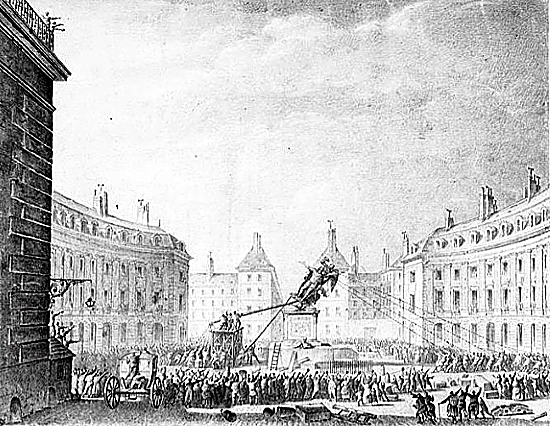FROM A SYMBOL OF TRIUMPHANT MONARCHY TO AN EFFIGY THAT A TREE TRUNK HOLDS UP
A statue finally appeared 30 years after the place was built.
(In 1643)
It was a statue of Louis XIII and was Prime Minister Richelieu's last gift to him.
- Made of bronze, it was melted down for cannons during the Revolution as were the statues of the four other places (in August 1792):
Zoom (please scroll down)
Place des Victoires
La Garde nationale par pour l'armée by Leon Cogniet, 1836 / zoom
The revolutionary tricolor on the site of the pont Neuf statue (in September 1792).
Louis XIII by Jean-Pierre Cortot, 1824
The challenge of equestrian statues: The horse must raise a hoof and not fall down.
- Jean-Pierre Cortot's works are conventional but competent. This one adorns the Arc de Triomphe:
- The regime had spent most of its budget on the statue for pont Neuf, and Cortot was obliged to use stone instead of bronze. The heavier weight made the work more difficult (a work in bronze is made from a mold whose inside is empty).
- A government that offered only "masses and masked balls" (George Sand) to a public used to immense victories or massive defeats, soon seemed boring. The tree trunk suggests that Cortot shared the public's indifference.
# # #
Louis XVIII said of his relationship with the French, "I am like a woman who is not very attractive, whom reason forces one to love."
-- Madame Royale by André Castelot, 1962 (in French)
The statue suggests a "pale monarchy"
for which the king does not try
for which the king does not try
to obtain a satisfactory image,
while the vigor of the original work
expresses the start of monarchy's Golden Age.
* * *
Next,
A church that changes the way to salvation
-- "Pale monarchy:"
René Chateaubriand, royalist writer,
Memories from Beyond the Grave (« Mémoires d'outre tomb »), 1848
* * *
Next,
A church that changes the way to salvation







No comments:
Post a Comment